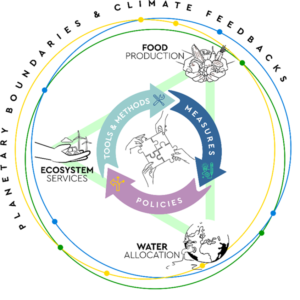Methodological approaches
LENSES follows a mixed methodology. On one hand, it is guided by hypothesis and the need for generalizable findings and broadly applicable methodologies and, on the other hand, by the need for a challenge-driven innovation approach.
Here below, you will find a general description of LENSES key approaches, while in the PILOT section you will find context specific information (e.g. challenges) which will drive their innovative application at local level.

At the heart of LENSES is the concept of “managing” the Nexus, and accepting the reality of trade-offs and synergies, thus the inherent nature of negotiation and mediation to any nexus management process. In accordance, LENSES sees conflict and cooperation as a continuum and these often co-exist and rather than reject conflict, the project will go deeper into the system to understand divergence of interest and social norms to work with this as part of a deep, transformative participatory approach. LAAs drive this transformation in LENSES.
LENSES will explore “what policy measures create effective drivers for change?”. The analysis will align with the EU’s objective on the evidence-based “multi-objective policy design”. In addition, the project will explore considerations as to participatory rights envisaged in a number of European instruments, which have a role in the success of resilient Nexus management.
Group Model Building will be used for SDM development with the aim of unravelling the complexity of WEF systems and support an improved understanding of their behavior. Departing from the assumption that the dynamic evolution of socio-environmental systems is largely caused by its own structure, LENSES will represent the underlying structure of WEF systems as a set of elements (stocks, flows, auxiliaries, parameters and constants, both physical and not-physical), the links between them, underlying equations, and multiple feedback interaction that can arise in either reinforcing or balancing loops.
The assessment of ecosystem services will be performed in relation to the hydrological sub-catchments under study. The coupling of the Soil & Water Assessment Tool (SWAT) with the Integrated Critical Zone model (ICZ) (through further development of the existing tool) will allow the mapping and quantification in spatial scales of soil ecosystem functions such as carbon sequestration, primary production and water filtration and contaminant and nutrient transformations.
Based on the understanding developed through the PSDM and combining with environmental and socio-economic data, the co-evaluations will be carried out through the development of the LENSES Nexus-SDG toolkit. The tool will use validated input to draw dependencies (as identified by users) and elucidate Sustainable Development pathways (e.g. field management practices).
Socioeconomic and policy-related valuation will explore if and to what extent the proposed NBS meet socio-economic sustainability criteria, in particular incorporating negative and positive externalities of the different water uses. Current hydropower, irrigation and drinking water services are not internalizing negative externalities into the tariff or bill systems and, therefore, the current nexus does not reach a perfect market allocation among different uses. LENSES will support the valuation of Environmental and Resource Costs (ERC), which plays a central role in the WFD, but is currently not sufficiently defined and implemented at basin scale. The project will also explore new financing, investment and business models to support NBS application and sustainability.
Taking advantage of natural processes, LENSES will support context specific, multi-functional NBS measures which can offer long-term sustainability through the conservation, sustainable management and restoration of the demonstration sites’ ecosystems. Vulnerabilities across the nexus domains will be reduced by harnessing ecosystem services and biodiversity through NBS. NBS is also seen here as a suitable vehicle to greening the CAP. Business models for Nexus-operationalization-through-NBS are described in the Innovation section below.
Due to their distinctive engagements with the natural environment, women’s experience and
knowledge are critical for environmental management.[1] In the LENSES Nexus contexts, using a gender perspective and enabling the integration of women’s knowledge of the environment will increase the chances of environmental sustainability. In accordance to the Charter of Fundamental Rights in the EU and the European Research Area (ERA) priority 4, will be implemented during the project based on the outcome of a Gender Situation Analysis and Needs Assessment (GSANA).
[1] United Nations Environment Programme (UNEP), 2004. Women and the Environment. Policy
Series.
